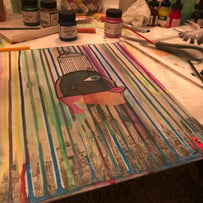Design and Mental Health
Micène Fontaine, May 30, 2020
May. Since 1949, May is Mental Health Month. While there has been progress, there is still a lot of stigma associated with mental health. It can be invisible to others (or relatively easily hidden in many cases), making it all the more damaging. For decades now, I have been dealing with anxiety and depression. With the help of professionals, I have acquired the tools to manage it. Some times better than others. I am stubborn and used to think I could and would beat it. I have since learned that it just does not work that way.
COVID-19 has accelerated societal shifts and exacerbated fault lines in global healthcare, education, and economy.
With 45% of people living in the USA feeling distressed and even higher numbers in other parts of the world, the U.N. has warned that a global mental health crisis is in the making.
So what can we do?
 Self-care: Take care of your mental health first. This might include the usual (sleep, exercise, nutrition) and being more mindful about what you read, watch, and listen to, and finding ways to connect with loved ones. Art (I use the term loosely as you can see from the illustration), meditation, running, and getting lost in my V.R. headset for a bit are some of the tools that work for me. Do what works for you.
Self-care: Take care of your mental health first. This might include the usual (sleep, exercise, nutrition) and being more mindful about what you read, watch, and listen to, and finding ways to connect with loved ones. Art (I use the term loosely as you can see from the illustration), meditation, running, and getting lost in my V.R. headset for a bit are some of the tools that work for me. Do what works for you.- The voices in your head: Mine is often filled with gloomy stories that have never happened - and probably never will. Part of the tools I mentioned earlier is learning to have better conversations with yourself (I know how it sounds). If you need help learning how to do that, listen to the Happiness Lab podcast as a starting point.
- Control what you can: Part of the mental distress is due to loss of control; yet, as design professionals, you know that the built environment affects our wellbeing. Therefore, design professionals play a critical role in designing environments that support both mental and physical health (both your own and that of others). From dementia to trauma, your design decisions will either support or hinder good health and wellbeing. You can help by learning evidence-based approaches you can implement to optimize mental health and wellness in any environment. We discuss some techniques in our Change by Design sessions on Trauma-Informed Design (with Dr. Jill Pable) and on Dementia Care (with Barbara Huelat) and in our text-based course on “Designing for Mental and Behavioral Health.” Consider putting biophilia high on your list of things to learn more about. Countless other resources are available for you to explore, but this much is certain: Wellness as a design trend has been accelerated, so keep an eye out for related content.
- Be gentle with yourself and those around you: Have you ever thought: Why would anyone do X ? or Why would anyone not do Y? I certainly have, but what do I know? No more than you or anyone else, so I try to reflect on why someone else’s behavior is bothering me. What’s a possible positive reason why they might be behaving that way? What am I not seeing?
If all else fails, I remind myself that we all process things differently and that, this too, is a form of diversity worth celebrating.
Here is to mental health. Let’s start with a deep breath.




